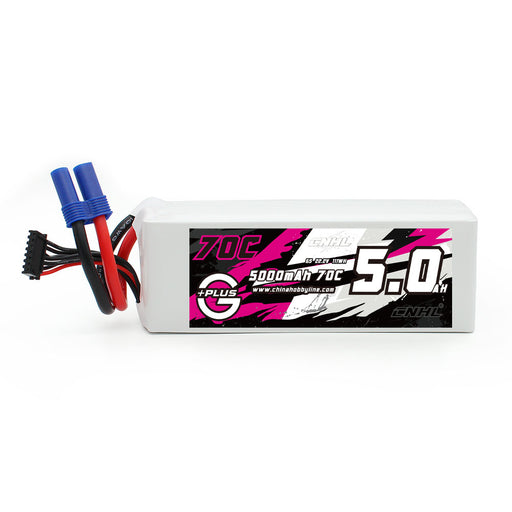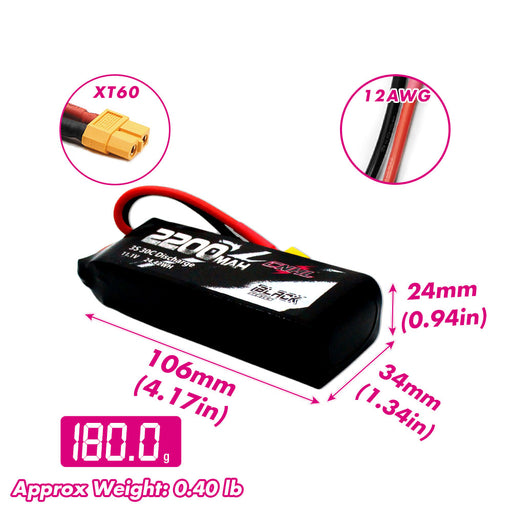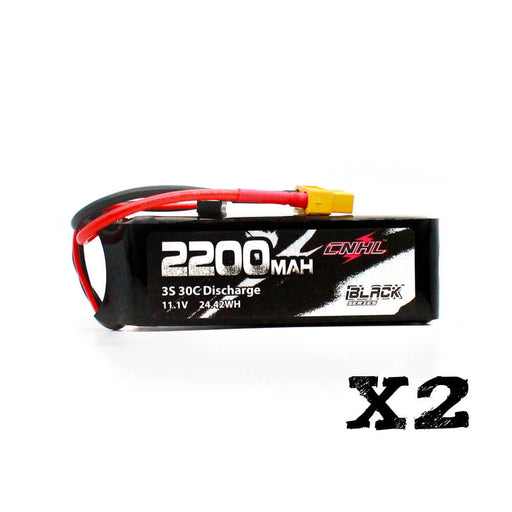
RC車両用リポバッテリーの健康状態をテストするためのガイド


ベストセラー
-
元の価格 $65.99元の価格 $65.99 - 元の価格 $65.99元の価格 $65.99$54.99 USD - $65.99 USD$54.99 - $65.99現在の価格 $54.99 USD
CNHL G+Plus 5000mAh 22.2V 6S リポバッテリー 70C EC5プラグ付き
在庫に10以上あります仕様: ストック番号: 500706EC5 容量: 5000mAh 電圧: 22.2V / 6セル / 6S1P 放電率: 70C 継続 / 140C バースト 充電率: 最大5C サイズ(1-5mmの誤差): 49X51X149mm(高さ*幅*長さ) おおよその重量(±5g) : 71...
詳細をすべて表示元の価格 $65.99元の価格 $65.99 - 元の価格 $65.99元の価格 $65.99$54.99 USD - $65.99 USD$54.99 - $65.99現在の価格 $54.99 USD最大17%節約 -
元の価格 $38.99元の価格 $38.99 - 元の価格 $38.99元の価格 $38.99$34.99 USD - $38.99 USD$34.99 - $38.99現在の価格 $34.99 USD
CNHL スピーディーピザシリーズ プロ 1350mAh 22.2V 6S 150C リポバッテリー XT60プラグ付き
在庫に10以上あります仕様: 在庫番号: 1351506PZ 容量:1350mAh 電圧:22.2V / 6セル / 6S1P 放電率:連続150C / バースト300C 充電率:最大5C サイズ(1-5mmの差異あり):38X38X78mm おおよその重量(±5g):215g 出力コネクター:XT60 バラン...
詳細をすべて表示元の価格 $38.99元の価格 $38.99 - 元の価格 $38.99元の価格 $38.99$34.99 USD - $38.99 USD$34.99 - $38.99現在の価格 $34.99 USD最大10%節約 -
元の価格 $51.98元の価格 $51.98 - 元の価格 $51.98元の価格 $51.98$45.98 USD - $51.98 USD$45.98 - $51.98現在の価格 $45.98 USD
2パック CNHL ブラックシリーズ V2.0 1300mAh 22.2V 6S 130C リポバッテリー XT60プラグ付き
在庫に10以上あります仕様 在庫番号: 1301306BK 容量: 1300mAh 電圧: 22.2V / 6セル / 6S1P 放電率: 130C 継続 / 260C バースト 充電率: 最大5C サイズ(1-5mmの差異あり): 48X33X77mm 重量(±5g): 210g 出力コネクター: XT60 バ...
詳細をすべて表示元の価格 $51.98元の価格 $51.98 - 元の価格 $51.98元の価格 $51.98$45.98 USD - $51.98 USD$45.98 - $51.98現在の価格 $45.98 USD最大12%節約 -
元の価格 $43.98 - 元の価格 $43.98元の価格 $43.98$43.98 USD$43.98 - $43.98現在の価格 $43.98 USD
[Combo] 2パック CNHL MiniStar 1500mAh 14.8V 4S リポバッテリー 120C XT60プラグ付き
在庫に10以上あります仕様: 在庫番号:1501204 容量:1500mAh 電圧:14.8V / 4セル / 4S1P 放電率:連続120C / バースト240C 充電率:最大5C サイズ(1-5mmの差異):37X33X76mm おおよその重量(±5g):169g 出力コネクター:XT60 バランスコネクター...
詳細をすべて表示元の価格 $43.98 - 元の価格 $43.98元の価格 $43.98$43.98 USD$43.98 - $43.98現在の価格 $43.98 USD -
元の価格 $23.98 - 元の価格 $37.98元の価格 $23.98 - 元の価格 $37.98元の価格 $23.98$19.98 USD - $37.98 USD$19.98 - $37.98現在の価格 $19.98 USD
2パック CNHL ブラックシリーズ 2200mAh 3S 11.1V 30C リポバッテリー XT60プラグ付き
在庫に10以上あります仕様: 在庫番号:220303BK 容量:2200mAh 電圧:11.1V / 3セル / 3S1P 放電率:30C連続 / 60Cバースト 充電率:最大5C サイズ(1-5mmの誤差あり):24X34X106mm おおよその重量(±5g):180g 出力コネクター:XT60 バランスコネク...
詳細をすべて表示元の価格 $23.98 - 元の価格 $37.98元の価格 $23.98 - 元の価格 $37.98元の価格 $23.98$19.98 USD - $37.98 USD$19.98 - $37.98現在の価格 $19.98 USD最大17%節約
新しいアイテム
-
元の価格 $122.99 - 元の価格 $122.99元の価格 $122.99$122.99 USD$122.99 - $122.99現在の価格 $122.99 USD
VOLANTEX BF109 RC 飛行機 4チャンネル RTF – ジャイロ&XPilot搭載 第二次世界大戦戦闘機
残り9台のみVOLANTEX BF109 4チャンネル RCプレーン RTFは、最も象徴的な第二次世界大戦の戦闘機の一つを、コンパクトで初心者に優しいパッケージにまとめました。400mmの翼幅、軽量なEPPフォーム製の機体、そしてXPilotジャイロシステムを備えたこの戦闘機は、新しいパイロットに滑...
詳細をすべて表示元の価格 $122.99 - 元の価格 $122.99元の価格 $122.99$122.99 USD$122.99 - $122.99現在の価格 $122.99 USD -
元の価格 $117.99 - 元の価格 $117.99元の価格 $117.99$117.99 USD$117.99 - $117.99現在の価格 $117.99 USD
Volantex RC プレーン P51D V2 400mm RTF – 初心者向けXPilotスタビライザー付き4CHウォーバード
残り9台のみVolantex RC Plane P51D V2 RTFは、学習をできるだけリラックスして行えるように設計されたコンパクトな第二次世界大戦スタイルの戦闘機です。400mmの翼幅、EPPフォーム構造、XPilot 6軸スタビライザーを備え、このVolantex RC飛行機は初心者に滑らかな...
詳細をすべて表示元の価格 $117.99 - 元の価格 $117.99元の価格 $117.99$117.99 USD$117.99 - $117.99現在の価格 $117.99 USD -
元の価格 $148.87 - 元の価格 $148.87元の価格 $148.87$148.87 USD$148.87 - $148.87現在の価格 $148.87 USD
MF-A84 690mm P-47スタイル ブラシレス RC 飛行機 (RTF、カメラなし)
残り9台のみMF-A84 690mmブラシレスRC飛行機は、P-47サンダーボルトやKi-84などのクラシック戦闘機に触発された戦闘機スタイルのモデルです。強力なブラシレスモーター、3モードジャイロシステム、EPPの耐久性、最大25分の飛行時間を備え、初心者から経験者まで簡単で刺激的な体験を提供しま...
詳細をすべて表示元の価格 $148.87 - 元の価格 $148.87元の価格 $148.87$148.87 USD$148.87 - $148.87現在の価格 $148.87 USD -
元の価格 $95.99 - 元の価格 $95.99元の価格 $95.99$95.99 USD$95.99 - $95.99現在の価格 $95.99 USD
CNHL G+Plus 6000mAh 22.2V 6S 100C リポバッテリー EC5プラグ付き
在庫に10以上あります仕様: ストック番号: 6001006EC5 容量: 6000mAh 電圧: 22.2V / 6セル / 6S1P 放電率: 100C 継続 / 200C バースト 充電率: 最大5C サイズ(1-5mmの差異): 40X66X170mm(高さ*幅*長さ) おおよその重量(±5g) : ...
詳細をすべて表示元の価格 $95.99 - 元の価格 $95.99元の価格 $95.99$95.99 USD$95.99 - $95.99現在の価格 $95.99 USD -
元の価格 $63.99 - 元の価格 $63.99元の価格 $63.99$63.99 USD$63.99 - $63.99現在の価格 $63.99 USD
CNHL G+Plus 6000mAh 14.8V 4S 100C リポバッテリー XT90プラグ付き
在庫に10以上あります仕様: 在庫番号:6001004 容量:6000mAh 電圧: 14.8V / 4-セル / 4S1P 放電率:連続100C / バースト200C 充電率:最大5C サイズ(1-5mmの差異あり):27X66X170mm おおよその重量(±5g):669.5g 出力コネクター:XT90 ...
詳細をすべて表示元の価格 $63.99 - 元の価格 $63.99元の価格 $63.99$63.99 USD$63.99 - $63.99現在の価格 $63.99 USD





















コメントを残す